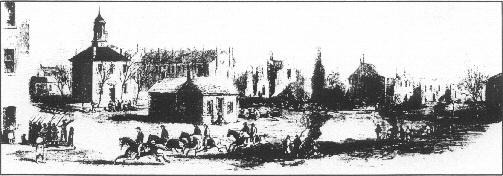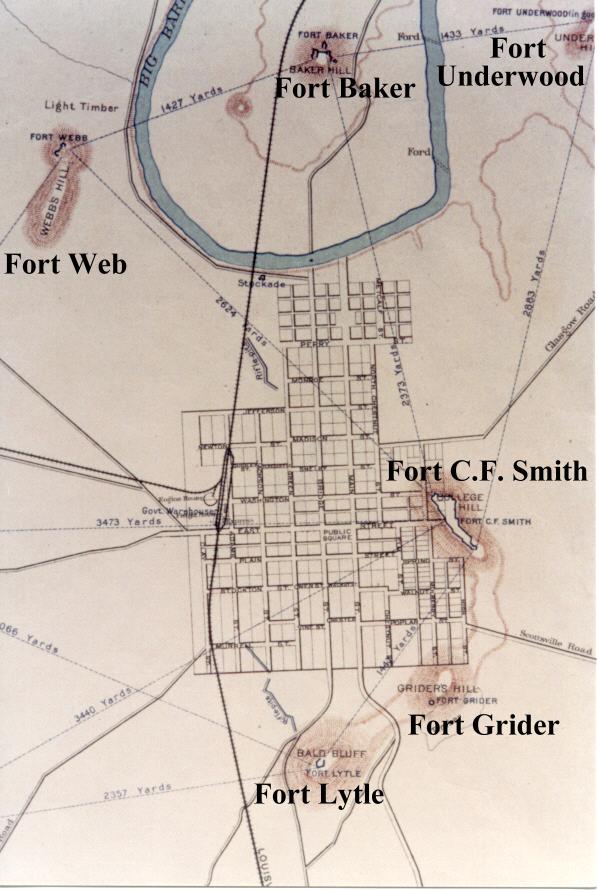
Bowling Green, Ky - Burned After The Confederates Marched Out
Harper's Weekly
March 15, 1862
On the evening of the 12th General Mitchell learned that the rebels
were preparing to evacuate Bowling Green, and had already shipped their
artillery to Nashville. He immediately determined to march upon them, and
At an early hour on the morning of Friday, the 14th, he started his men
in fine spirits, and eager to avail themselves of the opportunity for which
they had so long waited to show their mettle. The distance to be marched
was twenty-nine miles, six of which were over such a road as only Kentucky
can boast. But the march was easily made in nine hours, and At eleven o'clock
in the forenoon of Friday General Mitchell Appeared before the city, and
met the flag of truce which the rebels had the impertinence to send him,
requesting six hours in which to evacuate the place. General Mitchell replied
that he would not give them six minutes and, planting a rifled piece on
the slope of Baker Hill, he threw a shell or two among the thousand rebels
about embarking on the cars for Nashville. They hastily scrambled aboard
the train, which was as hastily put in motion, and disappeared, Hardee
and Hindman being left behind, and afterward escaping on horseback. Persons
here assert that these generals were afraid to join their men aboard the
cars, they having loudly declared their intention to have their revenge
upon them for their harsh treatment. Many of Hindman's men have often before
been heard to declare their intention to kill him at the first opportunity.
At the time of the shelling of the few troops remaining at the depot in Bowling Green the buildings of the railroad company were fired, and are now a mass' of ruins The depot and round house or machine-shop at this place were extensive and splendid buildings. The intention was doubtless to destroy the whole town; but the appearance of General Mitchell prevented this. The bridges across Barren River had been destroyed the day previous to the appearance of General Mitchell. He was compelled to wait until the day following, when he crossed and took possession of the city. The flag was raised over the Courthouse of a deserted city. I use the term in its literal sense. The rebels had for months been the only inhabitants. Many still find a home within the city limits. The pits where they lie are seen on every hill-side. It is estimated by the inhabitants here that not less than five thousand rebel soldiers have died of disease during the six months of occupation.
Bowling Green is described by the gazetteers as a pleasant and beautiful
city, lying in the valley of numerous hills which ride above its loftiest
buildings. But the gazetteers are not of late dates. Let those of the future
write it down as one whose beauty has departed. The houses look dingy and
dirty, and the streets like those of a country village during the muddy
season. It looks as if the shadow had settled upon it, never to be removed.
From the hills around it in every direction tile fortifications are frowning
and, as it were, withering with a frown. Once splendid residences graced
Mount Airy and Underwood's Hill, a vineyard lay on the side of Baker's
Hill and the green wheat and yellow corn were once seen in the valley at
the foot of Price's and Webb's. But Mount Airy has been despoiled of the
handsome building that graced Its brow, and in its place a lunette fort
frowns upon the river that glides silently by. The vineyard has been trampled
under foot, and the yellow corn has been gathered, and the wheat dares
not spring up. It seems as if the rebel presence had blighted the country
and the city. Inhabitants have fled and left their dwellings to be transformed
into hospitals or stables. Ruin and devastation have had their full away.
Bowling Green Civil War Map
